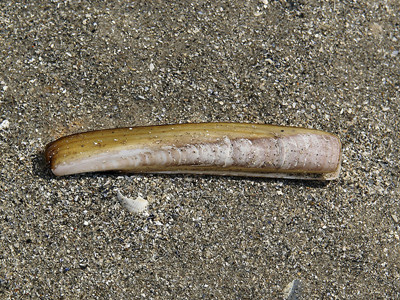A creature called the Atlantic razor clam had a secret.
科学家们已经揭开了这种名叫大西洋蛏子生物的神秘面纱。
Digging in wet sand should be slow and take lots of effort.
在湿砂中挖掘想必速度肯定会下降并且很费力。
But the razor clam could burrow a centimeter per second and go half a kilometer using only about a AA battery's worth of energy.
但是这种蛏子能够以每秒1厘米的速度并且只消耗相当于一节AA号电池的能量就可以挖掘半公里的深度。
These talents intrigued MIT researchers, who thought that a robotic version of the clam would have practical uses.
这一出众的才能引发了麻省研究人员们的兴趣,他们认为如果研制出机器版本的蛏子,可以实际大作为。
So they studied how the mollusk moves.
因此他们研究了软体动物的移动方式。

They found that the clam first contracts its shell.
他们发现蛏子首先会收缩自己的外壳。
That action causes sand to fall inward towards the animal.
这个动作造成沙子流向这种动物的内侧方向。
Further shell contraction draws water into the mix.
然后外壳收缩又引入水流与沙子混合。
At that point, the watery sand starts to behave as a fluid—think quicksand.
此刻,混合着水的沙子就可以向流体那样运动—想象一下流沙。
The drag on the burrowing clam is dramatically reduced and it starts to really move.
这样就明显减少挖掘中蛏子所受到的阻力并且可以真正实现向前移动。
The process requires pinpoint timing of contractions and digging.
而这一过程需要收缩及挖掘动作的精确配合。
Based on their findings, the researchers built a metal mimic.
基于这样的发现,研究人员们制造出了一种金属模拟物。
Its two halves contract and expand, and a rod digs through the sand.
它的两半同时可以收缩和扩张,并且伴有一个杆状物负责向前挖掘沙子。
They believe that an energy-efficient Roboclam could anchor an autonomous underwater vehicle, search for mines or lay underwater cables.
他们认为这样一种有效利用能量的机器蛏子可以用于固定寻找矿藏或安放于海底电缆之类的自动设备。
The scientists discuss their efforts in the journal Bioinspiration and Biomimetics.
科学家们在《生物灵感与生物模拟》杂志上对此进行了讨论。
Rather than clamming up.
至此蛏子再也不是默默无闻啦。












